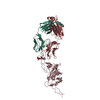+Search query
-Structure paper
| Title | A monoclonal antibody targeting a large surface of the receptor binding motif shows pan-neutralizing SARS-CoV-2 activity. |
|---|---|
| Journal, issue, pages | Nat Commun, Vol. 15, Issue 1, Page 1051, Year 2024 |
| Publish date | Feb 5, 2024 |
 Authors Authors | Leire de Campos-Mata / Benjamin Trinité / Andrea Modrego / Sonia Tejedor Vaquero / Edwards Pradenas / Anna Pons-Grífols / Natalia Rodrigo Melero / Diego Carlero / Silvia Marfil / César Santiago / Dàlia Raïch-Regué / María Teresa Bueno-Carrasco / Ferran Tarrés-Freixas / Ferran Abancó / Victor Urrea / Nuria Izquierdo-Useros / Eva Riveira-Muñoz / Ester Ballana / Mónica Pérez / Júlia Vergara-Alert / Joaquim Segalés / Carlo Carolis / Rocío Arranz / Julià Blanco / Giuliana Magri /   |
| PubMed Abstract | Here we report the characterization of 17T2, a SARS-CoV-2 pan-neutralizing human monoclonal antibody isolated from a COVID-19 convalescent individual infected during the first pandemic wave. 17T2 is ...Here we report the characterization of 17T2, a SARS-CoV-2 pan-neutralizing human monoclonal antibody isolated from a COVID-19 convalescent individual infected during the first pandemic wave. 17T2 is a class 1 VH1-58/κ3-20 antibody, derived from a receptor binding domain (RBD)-specific IgA memory B cell, with a broad neutralizing activity against former and new SARS-CoV-2 variants, including XBB.1.16 and BA.2.86 Omicron subvariants. Consistently, 17T2 demonstrates in vivo prophylactic and therapeutic activity against Omicron BA.1.1 infection in K18-hACE2 mice. Cryo-electron microscopy reconstruction shows that 17T2 binds the BA.1 spike with the RBD in "up" position and blocks the receptor binding motif, as other structurally similar antibodies do, including S2E12. Yet, unlike S2E12, 17T2 retains its neutralizing activity against all variants tested, probably due to a larger RBD contact area. These results highlight the impact of small structural antibody changes on neutralizing performance and identify 17T2 as a potential candidate for future clinical interventions. |
 External links External links |  Nat Commun / Nat Commun /  PubMed:38316751 / PubMed:38316751 /  PubMed Central PubMed Central |
| Methods | EM (single particle) |
| Resolution | 3.46 - 4.41 Å |
| Structure data |  EMDB-16453: SARS-CoV-2 Omicron Variant Spike Trimer in complex with three 17T2 Fabs EMDB-16473, PDB-8c89: |
| Source |
|
 Keywords Keywords |  VIRAL PROTEIN / Complex SARS-CoV-2 Spike S 17T2 VIRAL PROTEIN / Complex SARS-CoV-2 Spike S 17T2 |
 Movie
Movie Controller
Controller Structure viewers
Structure viewers About Yorodumi Papers
About Yorodumi Papers







